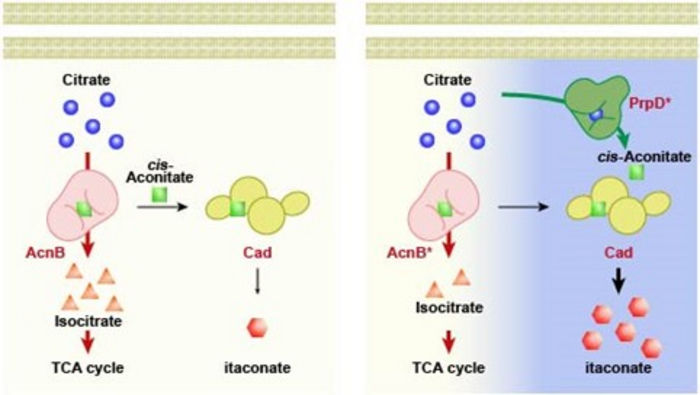Steel mill gases transformed into bioplastic
Korea-Spain joint research team develops an itaconic acid mass production method using artificial enzymes
Food delivery makes it easy to enjoy delicious food in a snap. However, the plastic waste from food deliveries is rapidly polluting the environment and threatening our future. An alternative that has emerged is bioplastic, which is also called biodegradable plastic. Bioplastic that uses eco-friendly raw materials emits less pollutants during the production process and has natural decomposition properties. Recently, a Korea-Spain joint research team recreated bioplastic from wasted byproducts from gas fermentation from steel mills.

Comparison of itaconic acid production in the natural metabolic pathway in E. coli and the construction of a new itaconic acid biosynthesis pathway through the introduction of a new artificial enzyme. The itaconic acid production increased as a result.
POSTECH
Through joint research with Spain's Center for Research in Agricultural Genomics (CRAG), a research team led by Professor Gyoo Yeol Jung, Ph.D. candidates Dae-yeol Ye and Jo Hyun Moon, and Dr. Myung Hyun Noh in the Department of Chemical Engineering at POSTECH has developed a technology to generate artificial enzymes from E. coli. The joint research then succeeded in mass-producing itaconic acid, a source material for bioplastic, from acetic acid in E. coli
Recognized for its significance, this study was recently published in the Editor’s Highlights section of the international academic journal Nature Communications.
Itaconic acid produced by fungi with membrane-enclosed organelles is used as a raw material for various plastics, as well as cosmetics and antibacterial agents. Although its global market value is estimated high at around 130 billion KRW (USD 91 million) this year, its production and utilization have been limited due to the complex production process and high cost of production.
For this reason, studies are being actively conducted to produce itaconic acid with industrial microorganisms such as E. coli. Although E. coli can be produced using inexpensive raw materials and is easy to culture, additional raw materials or processes were required to produce itaconic acid since it lacks membrane-enclosed organelles.
Using biosynthesis, the joint research team developed an artificial enzyme to pave the way for E. coli to directly produce itaconic acid without membrane-enclosed organelles. The research results showed that the newly developed enzyme can be used in E. coli to produce itaconic acid. With this technology, it is now possible to build a microbial cell factory that can easily produce itaconic acid from cheap and various raw materials.
This research result is evaluated as a key original technology for producing itaconic acid from byproduct of gas fermentation products from steel mills, seaweed, as well as agricultural and fishery byproducts such as lignocellulosic biomass. By replacing the raw material from petrochemicals with biosynthesized itaconic acid, the new technology is anticipated to contribute to a carbon-neutral society and significantly expand the itaconic acid market.
Original publication
Original publication
Ye, Dy., Noh, M.H., Moon, J.H. et al. Kinetic compartmentalization by unnatural reaction for itaconate production. Nat Commun 13, 5353 (2022)
Topics
Organizations
Other news from the department science

Get the life science industry in your inbox
By submitting this form you agree that LUMITOS AG will send you the newsletter(s) selected above by email. Your data will not be passed on to third parties. Your data will be stored and processed in accordance with our data protection regulations. LUMITOS may contact you by email for the purpose of advertising or market and opinion surveys. You can revoke your consent at any time without giving reasons to LUMITOS AG, Ernst-Augustin-Str. 2, 12489 Berlin, Germany or by e-mail at revoke@lumitos.com with effect for the future. In addition, each email contains a link to unsubscribe from the corresponding newsletter.





















































